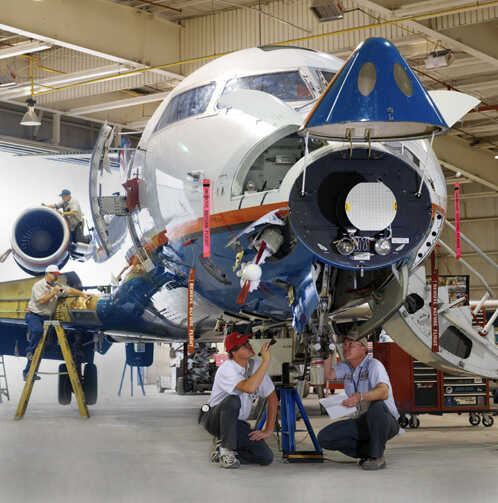Bridging the Gap: MRO Training & Education for the Future of Aviation

One of the major pain points for aviation in 2024 continues to be projected workforce shortages in the maintenance, repair, and overhaul (MRO) sector.
Aviation MRO plays a crucial role in ensuring the safety and efficiency of aircraft operations worldwide. As the global fleet continues to grow and evolve, the demand for skilled MRO professionals is reaching unprecedented levels.
MRO training and education are in the spotlight as OliverWyman projects a supply deficit of up to 48,000 aircraft maintenance workers in North America by 2027 – a shortfall of about 27 percent.
Boeing this summer released even more dire predictions this summer, saying that the world will need 716,000 new maintenance technicians over the next 20 years – numbers that are sure to exacerbate workforce shortages.
“Boeing noted that insufficient training capacity to support the personnel shortage and the lag time required to bring new staff online would be major challenges for meeting this demand,” said Aviation Week.
Let’s look at the importance of MRO training and education in addressing future workforce needs and examine the various options and initiatives currently being implemented to tackle this pressing issue.
The Current Workforce Crisis in Aviation MRO
The aviation MRO sector is grappling with a severe shortage of qualified personnel, a crisis that threatens to impact the industry's ability to meet growing demand and maintain safety standards.
This shortage stems from several factors:
- An aging workforce with a high number of retirements.
- Rapid technological advancements requiring new skill sets.
- Competition from other industries for skilled workers.
- Insufficient awareness of MRO career opportunities among young people.
- Shortage of qualified instructors and designated maintenance examiners.
The impact of this shortage is far-reaching, leading to increased labor costs, longer maintenance turnaround times, and potential safety concerns if not addressed promptly.
The Importance of MRO Training and Education
Effective training and education in the MRO sector are paramount for several reasons:
- Ensuring safety and compliance: Properly trained technicians are essential for maintaining aircraft safety and adhering to strict regulatory standards.
- Keeping up with technological advancements: As aircraft become more sophisticated, MRO professionals must continually update their skills to work with new systems and materials.
- Meeting industry standards and regulations: Training programs help ensure that MRO personnel are well-versed in the latest industry standards and regulatory requirements.
- Improving efficiency and productivity: Well-trained staff can perform tasks more quickly and accurately, reducing downtime and improving overall operational efficiency.
Investing in comprehensive MRO training and education is not just a necessity but a strategic imperative for the aviation industry to maintain its high standards of safety, efficiency, and innovation.
Current Training and Education Options
The aviation MRO industry offers various training and education options to develop the skilled workforce it needs:
- Traditional vocational schools and community colleges: These institutions provide foundational knowledge and hands-on experience in aviation maintenance.
- Manufacturer-specific training programs: Aircraft and component manufacturers offer specialized training on their products.
- On-the-job training and apprenticeships: Many MRO companies provide in-house training programs to develop skills specific to their operations.
- Online and virtual learning platforms: E-learning solutions offer flexibility and accessibility for continuous skill development.
In Europe, for example, aviation training provider Resource Group is expanding its remote learning and testing opportunities for future maintenance technicians to address the region’s MRO skills shortage, according to Aviation Week.
“The benefits of self-study learning are well documented, including improved knowledge retention, flexibility, and cost-effectiveness—all crucial requirements which we identified in our post-pandemic customer base,” Stuart Johnson of Resource Group told the publication.
Innovative Approaches to MRO Education
To tackle the workforce shortage, the industry is exploring new and innovative approaches to MRO education:
- Partnerships between industry and educational institutions:
- Collaborative curriculum development.
- Industry-sponsored training facilities.
- Guest lectures and workshops by industry experts.
- Simulation and virtual reality training:
- Immersive learning experiences.
- Safe environment for practicing complex procedures.
- Cost-effective training on rare or expensive equipment.
- Mentorship programs:
- Pairing experienced professionals with new entrants.
- Knowledge transfer and career guidance.
- Fostering a sense of community within the industry.
- Continuous learning and upskilling initiatives:
- Regular refresher courses.
- Cross-training opportunities.
- Certification programs for specialized skills.
These innovative approaches are helping to create more engaging, effective, and accessible training programs that can attract and retain talent in the MRO industry.
Challenges in Implementing Effective MRO Training Programs
Despite the promising initiatives, implementing effective MRO training programs faces several challenges:
- Cost considerations: Developing and maintaining up-to-date training programs can be expensive, particularly for smaller MRO providers.
- Keeping curriculum up to date: The rapid pace of technological advancement requires constant updating of training materials and methods.
- Attracting young talent to the industry: The MRO sector must compete with other industries that may be perceived as more attractive to younger generations.
Overcoming these challenges requires a concerted effort from all stakeholders in the aviation MRO ecosystem, including companies, educational institutions, and regulatory bodies.
Role of MRO Companies in Addressing the Skills Gap
MRO companies play a crucial role in addressing the skills gap:
- In-house training programs:
- Tailored to specific company needs.
- Combining classroom instruction with hands-on experience.
- Opportunities for career advancement.
- Collaboration with educational institutions:
- Providing equipment and expertise for training programs.
- Offering internships and co-op opportunities.
- Participating in curriculum development.
- Offering internships and apprenticeships:
- Introducing students to real-world MRO environments.
- Building a pipeline of future employees.
- Providing mentorship and guidance.
By taking an active role in training and education, MRO companies can help shape the future workforce and ensure a steady supply of skilled professionals.
Outlook and Recommendations
To address the ongoing challenges in MRO training and education, the industry should consider the following recommendations:
- Embracing technology in training:
- Invest in VR and AR training solutions
- Develop adaptive learning platforms
- Utilize data analytics to personalize training programs
- Promoting aviation MRO as a career path:
- Engage with schools and youth organizations
- Highlight the high-tech nature of modern MRO work
- Emphasize career stability and growth opportunities
- Government and industry collaboration:
- Develop national strategies for MRO workforce development
- Provide incentives for companies investing in training programs
- Create standardized certification programs.
By implementing these recommendations and continuing to innovate in training and education, the aviation MRO industry can work towards closing the skills gap and ensuring a robust workforce for the future.
As companies like Source One Spares continue to prioritize workforce development, they not only secure their own future but also contribute to the overall safety, efficiency, and growth of the global aviation industry.



